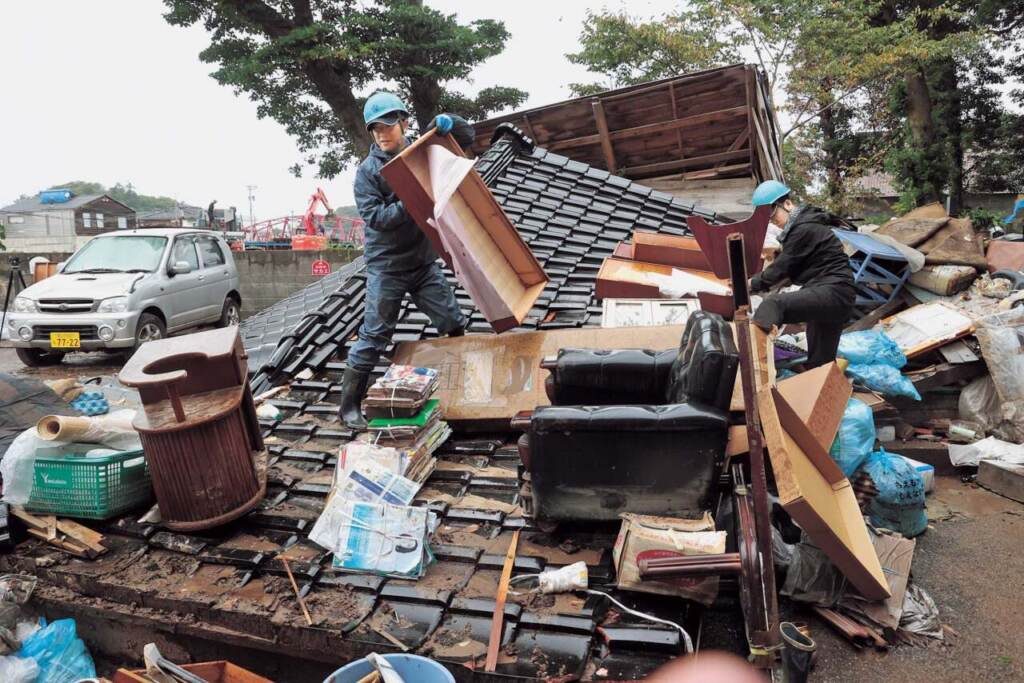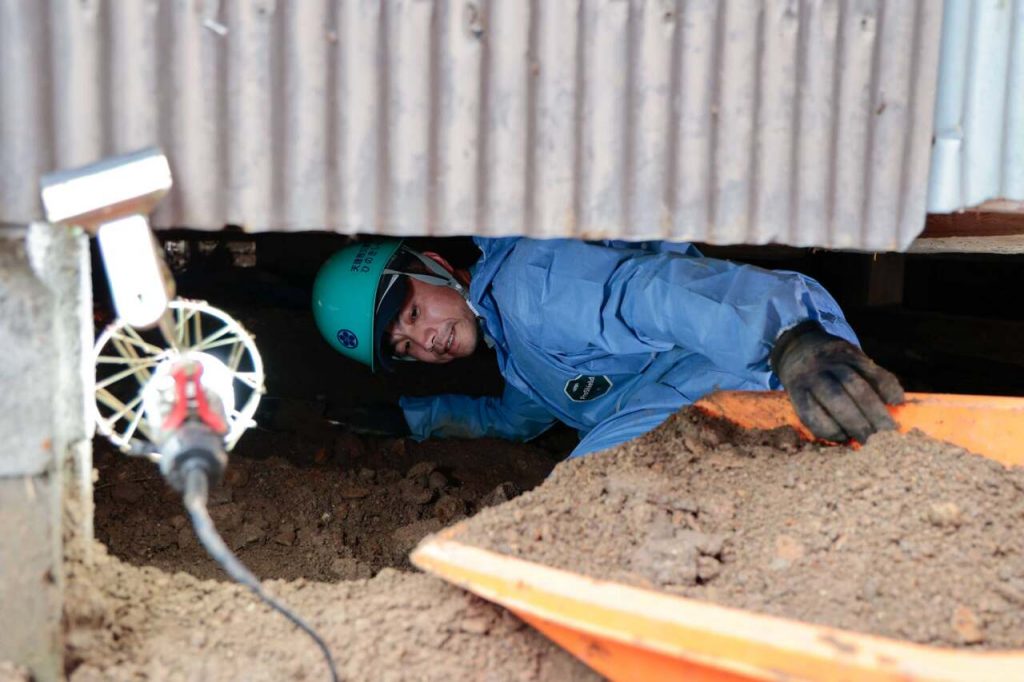In the Noto region of Ishikawa Prefecture, which still suffers from the effects of the 2024 Noto Peninsula Earthquake, Tenrikyo Disaster Relief Hinokishin Corps carried out relief activities in the city of Wajima from September 28 to October 17. With a total of 451 members mobilized, the corps worked primarily in areas affected by flooding and mudslides due to heavy rains, providing crucial assistance and support to residents by removing debris and mud from damaged homes. Many locals expressed their gratitude for the prompt responses tailored to their needs.
On September 21 and 22, a linear precipitation band developed and brought torrential rain to the Noto region. The heavy rain caused the overflow of 28 rivers in the area, leading to landslides and flooding of homes, particularly in the cities of Wajima and Suzu. These two cities, already significantly impacted by the earthquake in January, are located at the tip of the Noto Peninsula, where the recovery of infrastructure has been delayed. Signs of earthquake damage persisted there even nine months later. The rain also further compromised temporary repairs on damaged river embankments, worsening the impact of the flooding. In Wajima City in particular, due to the overflow of the Kawarada River, 20 evacuation shelters were set up, and 418 people were forced to evacuate. The flooding affected five temporary housing complexes built after the earthquake. Residents were again displaced to evacuation centers and exposed to uncertainty about their futures.
On September 23, Ishikawa Diocese held a disaster counteraction committee meeting to assess the damage in the region. After the vice director of Tenrikyo Disaster Relief Hinokishin Corps visited the disaster-stricken site on the 24th and 25th, it was decided on the 27th that Ishikawa and Fukui diocese corps would be dispatched. Part of the Noto Airport Campus of Japan Aviation College in Wajima City was designated as their base. Ishikawa diocese corps was deployed from September 28 to October 1, with Fukui diocese corps joining that corps on September 30 and October 1.
Ishikawa diocese corps initially helped residents in Kawaimachi, Wajima City, where members removed household items damaged by floodwater and cleared mud from under floors. On September 29, they worked in Futasemachi, Wajima City, by using two-ton trucks and mini trucks to transport disaster waste to collection sites. On the 30th, Fukui diocese corps joined the effort and carried out similar operations in the areas of Futasemachi and Fugeshimachi. On October 1, they transported disaster waste from Kawaimachi. During this period, a total of 27 members of Ishikawa diocese corps removed waste and mud from under floors and yards in four homes with a total of 22 members from Fukui diocese corps participating on September 30 and October 1.
On October 2, the headquarters corps arrived on-site and began relief activities, joined by Niigata and Gifu diocese corps that evening. After a formation ceremony, the members of these corps deployed to Wajima City, where they cleared disaster debris and mud from flood-damaged homes. On October 3, Niigata diocese corps members assisted at a damaged home in Kawaimachi and removed water-damaged household items and a collapsed roof.

A male resident in his 70s, who had requested assistance with debris removal, said: “The water surged over the concrete block wall surrounding my home and flooded the first floor in moments. My family and I are elderly and couldn’t move the debris ourselves, so I’m incredibly grateful.” Another resident expressed relief by saying: “I was considering repairing my partially damaged home after the earthquake, but after this flood, I thought it might no longer be possible. The corps’ help in clearing everything is a lifesaver.”
Rev. Kiyohito Yoshizawa (50, head minister of Niitsu Branch Church), who led Niigata diocese corps, stated: “We encountered residents with a range of issues, both major and minor. Rather than setting priorities to the tasks, we aimed to address each immediate need, one at a time, to help as many affected people as possible find peace.”
The secretary-general of Wajima City’s social welfare council, which requested assistance from the Disaster Relief Hinokishin Corps, said: “We were planning to scale down the volunteer center after nine months of earthquake recovery when this rain disaster struck. Both the social welfare council and the residents felt it was a devastating setback. The corps’ help in removing disaster waste from homes is a great relief. We have built a trusting relationship with the corps since the earthquake, and their coordinated efforts have been invaluable. We hope they continue their support so that affected residents can look ahead with hope.”
From October 5 to 8, Toyama and Shiga diocese corps arrived, followed by Fukui and Aichi diocese corps on October 8.
On October 16, some Gunma diocese corps members arrived at a damaged home in Higashinakao Town of Wajima City. According to the homeowner, a 66-year-old carpenter, when he hurried back from a job site during the heavy rain, he found the area surrounding his house covered in mud and driftwood from the nearby mountain. “My workshop, vital to my trade, was buried under tons of mud, and all my tools were unusable. The corps cleared this enormous amount of mud, giving me the first step back toward resuming work. I am truly grateful.”

Another team from Gunma diocese corps worked on clearing mud from under a flooded house in Yamamotomachi Town. They crawled into a narrow 30-centimeter (1-ft.) space under the floor to shovel out mud and passed it along a line of corps members to a collection point outside. Then they transported it to a disposal site by mini truck. The elderly homeowner, an 80-year-old woman, said: “I never imagined they’d be so thorough by clearing the deep mud from under the house. Seeing the members smiling and working despite the mud lifted my spirits.”
The corps’ disaster relief efforts, which began on September 27, continued until October 17, involving five groups and a total of 451 members. They removed approximately 333 tons of disaster debris and mud from 28 affected homes.




